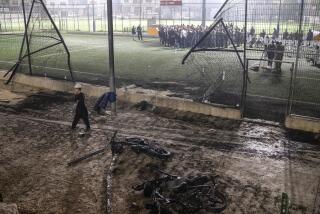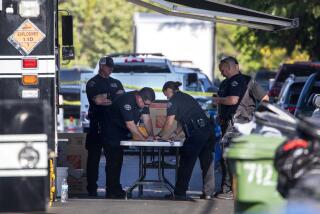Caves Full of Explosive Surprises
MANDEIKOL, Afghanistan — The demolition specialists took the customary precautions.
They moved the residents of this settlement in eastern Afghanistan well away from the cave where 90 Russian rockets had been found Saturday. They had U.S. soldiers take cover about half a mile away, behind two massive rock formations.
Only then did Staff Sgt. Jeffrey Wade, the team leader, detonate 45 blocks of C-4 explosive intended to destroy the rockets and keep them out of enemy hands.
The size of the explosion stunned even Wade. It painted the evening sky red and sent tremendous shock waves across the mountains. It turned ordinary rocks into lethal projectiles, hurling them like meteorites for more than 1,000 yards.
One stone slammed into the helmet of Pfc. John Blyer, knocking him unconscious. Another stone smashed into the left ankle of Pfc. Gabriel Watt, leaving him howling in pain.
“Medic! Medic!” soldiers screamed in the dark as a towering plume of flame and black smoke rose over the mountains.
For the 82nd Airborne Division soldiers on this mission into the wilderness, the mishap added yet another danger to an already perilous job.
Afterward, with the two injured soldiers evacuated and hospitalized in stable condition, Wade was at a loss to explain what had happened.
“This was very atypical,” said Wade, a slender, meticulous demolition expert from Louisiana. “The only thing I can figure is that maybe there was more ordnance underneath the rockets that we didn’t see.”
Even before the injuries, officers and soldiers of the 1st Battalion, 505th Parachute Infantry Regiment had been on an unusual mission. It was the first time they had been directed to significant weapons caches rather than discovering caches during regular combat sweeps.
Gen. Mullah Abdel Razeq, a militia commander who controls the Kohe Safi mountains northeast of Kabul, the Afghan capital, had told U.S. commanders at nearby Bagram air base about several caves containing rockets and other weapons. Rockets are fired at American troops in Afghanistan almost daily, so those in the caves are considered a “direct and immediate threat” to Bagram.
The Kohe Safi range is so rugged and forbidding that troops had to be flown in by helicopters that made harrowing landings in narrow gorges. One Chinook pilot hovered over a rocky outcrop, with only the rear wheels touching ground, until soldiers leapt out.
Besides helicopter crashes, other potential dangers included snipers, a startled villager opening fire, land mines, radio failures, booby traps and even dog bites and twisted ankles.
The troops also worried about oversights. One Chinook was delayed when a sergeant found a grenade pin and ordered everyone aboard to check their grenades. The same sergeant warned his men that because the helicopters would be landing on inclines, anyone who didn’t crouch low when exiting risked decapitation.
Most of the men had phoned loved ones the night before. They tucked photos into their helmet liners and a few kissed them for good luck.
“This is a dangerous job in a dangerous place,” Capt. Stephen Snyder said. “Anything can happen.”
*
The men of Alpha Company found Razeq and his militiamen waiting at the landing zone Saturday morning. Earlier, officers had flown Razeq over the area to have him point out the caches. He spotted some and promised to locate others on a map. But when he produced a map later, it was a large-scale tourist map, without the coordinates needed to pinpoint the sites.
That meant the troops would have to hike for hours through gorges to the caches, following the translated directions of the militia commander. It helped that a small team of coalition special forces soldiers had hiked with militiamen to the caches the day before with global positioning systems that provided map coordinates.
Although the general was a professed anti-Taliban commander, the loyalties of his militiamen were anyone’s guess. Many men in the area had fought with or supported the Taliban. The Americans assumed that some of Razeq’s men were willing to give or sell information to the enemy.
The general’s motives were less opaque.
“He wants to get rid of this stuff because he doesn’t want to be held responsible for any rocket attack from his region against U.S. forces,” said Maj. Craig Osborne, the battalion’s operations officer.
The U.S. commanders brought civil affairs specialists to interview villagers, explain the mission and gather useful intelligence; combat medics and the battalion surgeon; ordnance and demolition specialists and engineers equipped with a tiny wheeled robot; and military intelligence specialists.
Also on hand were psychological operations specialists to “spread the word, let people know what we’re doing, give them the big picture, the World Trade Center, the whole nine yards,” as Staff Sgt. Samuel Escobar put it.
It was a two-hour hike to the first two caches. Both were inside caves carved from the rock face above a stream bed. One had 90 Russian 122-millimeter rockets and the other held two dozen more.
Wade said the rockets probably dated from the Soviet occupation of the 1980s. They were still functional.
As Wade’s team inspected the caves for booby traps, civil affairs officers herded the villagers of a nearby mud-hut compound to safety in another compound half a mile away. Herders moved their goats.
The Americans began hiking to a spot behind the two towering rock formations.
Wade calculated the fragmentation range for exploding shrapnel and rock at just over 300 yards. The blast range, he calculated, was 1,145 yards. He and his men set the charges for each cache.
When Wade hiked to where the soldiers were taking cover, he saw several standing on open ground, hoping to get a look at the explosion. He ordered them to move farther back, behind the rock formations. They were 1,050 yards from the blast site.
The smaller cache blew first, and the blast wave pounded the mountains and crashed over the soldiers. There were shouts and loud hoots from the men.
The second explosion was much bigger. Soldiers who were standing and watching the massive eruption of flame and smoke suddenly dived for cover as they realized that huge rocks were hurtling their way.
A rock knocked off Blyer’s helmet and leveled him. Another crushed Watt’s ankle.
A rock the size of a watermelon crashed with a thud three feet from where Pfc. Ananias Whitfield, 19, had taken cover. He looked up, pale and wide-eyed, and said quietly, “I almost died right now.”
The medics were there in seconds, cutting off Watt’s bloody boot and cradling Blyer’s ashen face as he passed in and out of consciousness. Blyer was moaning softly. Watt was bellowing and cursing in pain.
Minutes later, Maj. Eric Fisher, the battalion surgeon, rushed over and ordered the medics not to let Blyer move his head.
They secured Blyer’s neck with a cervical collar as Fisher asked Blyer his name and social security number. Groggily, Blyer responded. They tied him to a stretcher, still conscious.
Fisher examined Watt and determined that he probably had a fracture. His ankle was bound in a splint. Watt begged for water and screamed for someone to squeeze his hand.
“It hurts!” he shouted.
“I know, I know,” the surgeon said.
Soon a helicopter arrived from Bagram, its rotors beating and its silhouette a dark stain on the mountains. It roared off minutes later, ferrying the two soldiers to the military hospital at Bagram.
Silently, the rest of the company hiked back to the landing zone in the dark.
*
The next morning, some of the men were still talking about the size of the rocks that had just missed them the night before. They asked about Blyer and Watt.
No one blamed the demolition team for the close call. But Wade, asked whether he would move soldiers much farther back for future detonations than guidelines recommend, replied, “Of course, absolutely.”
At the landing zone, Gen. Razeq arrived to provide directions to more rocket caches and to offer condolences for the two injured soldiers to Lt. Col. Ronald J. Rose Jr., the battalion commander.
The American and the Afghan conferred on a rocky plateau. The general, who had received complaints from villagers that he had not passed on American warnings of the impending detonations, asked for a better warning system.
Rose took a whistle from one of his captains and said: “You saw yesterday how large these explosions are. So before we blow them today, we’ll whistle to warn people.”
The colonel blew loudly on the whistle, and the general grinned and nodded his head.
The two commanders discussed how they would find and detonate more rocket caches that afternoon.
“These caches are very dangerous,” Rose said when they had finished.
“Yes, yes,” Razeq replied. “That’s why we don’t try to move them.”
As the session was ending, Sgt. 1st Class Ruben Garcia walked to the edge of the landing zone. He noticed a small cave and peered inside. There, just yards from where the men of Alpha Company had slept the night before, lay more than 50 neatly stacked and fully armed rockets, mortars and rocket-propelled grenades.
More to Read
Sign up for Essential California
The most important California stories and recommendations in your inbox every morning.
You may occasionally receive promotional content from the Los Angeles Times.











